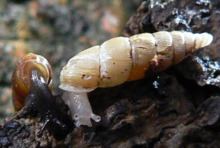Kingdom Animalia Superfamily Clausilioidea Subfamily Clausiliinae Scientific name Pseudofusulus varians Rank Species | Class Gastropoda Family Clausiliidae Tribe Clausiliini Phylum Mollusca | |
 | ||
Similar Cochlodina costata, Ruthenica filograna, Macrogastra plicatula, Macrogastra, Laciniaria plicata | ||
Pseudofusulus varians is a species of air-breathing land snail, a terrestrial pulmonate gastropod mollusk in the family Clausiliidae.
Contents
Genus Pseudofusulus is monotypic genus (contains one species only) with Pseudofusulus varians as its type species.
It is a relict species from Atlantic period of the Holocene, inhabiting exclusively nature beech and scree forests in Europe.
Distribution
The distribution of this species is Eastern Alpine and Western Carpathian. The type locality is the High Alps in Styria, Austria.
The key area of its range is in the Western Alps (from the south-western part of the Alps to Croatia, and also to the Dolomites in the southern Tyrol).
Description
The shell is horny or greenish brown and finely ribbed. The shell has 9-10 whorls. The apertural margin is detached. Columellaris is deep inside and forked, hardly visible in a perpendicular view. Palatal wall is white and prominent. There is no lunula. Subcolumellaris is very close to basal furrow, visible in an oblique view. Clausilium is not very concave.
The width of the shell is 2.2–3 mm. The height of the shell is 9–12 mm.
Habitat
Pseudofusulus varians is very exacting on the quality of its environment and its populations are small and quite scattered in the whole of its range.
It lives in virgin-like forests and old-growth forest with fallen dead wood (coarse woody debris) in montane and submontane. It is found in humid and shady habitats in woods, under ground litter and stones, in mountains. In the Czech Republic it is strictly associated with trees, restricted to undisturbed and hardly accessible natural beech forests. Pseudofusulus varians is strictly dendrophilous species, so the main threat is dead wood removing and clearcutting.
As it is endangered in the whole Europe, it is very important to protect its modern sites.
